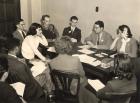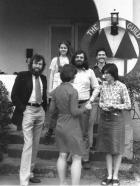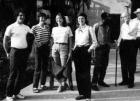Before NASCO, 1946
 Meeting 1940's (1) NASCO is the successor of NASCL, the North American Student Cooperative League, founded in 1946 with the assistance of the Cooperative League of the USA (now called the National Cooperative Business Association, or NCBA). In turn, NASCL was created by and replaced several regional associations which were formed starting in the late 1930s, again with the help of CLUSA/NCBA. Although NASCL was greatly needed, it was never a strong organization and after the mid-1950s existed largely on paper. The needs for communication, assistance, education, lobbying and other kinds of services didn’t end, however, and NASCL remained as a concept, particularly in Ann Arbor.
Meeting 1940's (1) NASCO is the successor of NASCL, the North American Student Cooperative League, founded in 1946 with the assistance of the Cooperative League of the USA (now called the National Cooperative Business Association, or NCBA). In turn, NASCL was created by and replaced several regional associations which were formed starting in the late 1930s, again with the help of CLUSA/NCBA. Although NASCL was greatly needed, it was never a strong organization and after the mid-1950s existed largely on paper. The needs for communication, assistance, education, lobbying and other kinds of services didn’t end, however, and NASCL remained as a concept, particularly in Ann Arbor.
NASCO's Inception (1968-1978)
 NASCO Board 1975: In the spring of 1968, participants in a conference sponsored by the University of Michigan Inter-Cooperative Council proposed the organization of a group "for the purpose of expanding the cooperative movement across college campuses." In the fall, a group gathered in Chicago to organize NASCO.
NASCO Board 1975: In the spring of 1968, participants in a conference sponsored by the University of Michigan Inter-Cooperative Council proposed the organization of a group "for the purpose of expanding the cooperative movement across college campuses." In the fall, a group gathered in Chicago to organize NASCO.
NASCO's creation in 1968 meant that, for the first time in 20 years, student co-ops began working together towards their common interests.
NASCO began its work almost immediately on co-op development. Through a strong lobbying effort, student co-ops were able to get the federal government to allow the College Housing Program to make loans directly to them. These 3%, 30 -40 year term loans allowed student co-ops to be built in Berkeley, Los Angeles, Ann Arbor, Minneapolis, and Austin. NASCO's creation also added momentum to the strong student co-op development activity in Canada.
During this time of federally funded expansion, and throughout it's early years, NASCO's annual Conferences provided the organizational initiative and support for many student co-ops. The inspiration for new co-ops, and the ideas to improve the operations of ones that already were established, were generated at these conferences, providing the "ideological" support to effectively utilize the government loans. Also, these early conferences helped to organize many of the 'new wave' food co-ops.
In the fall of 1977, NASCO's regional conferences were replaced by the NASCO Cooperative Education and Training Institute, again providing affordable, essential inspiration and training for student co-opers. As with the Conferences, the Institute served, and serves today, as place for education, inspiration, and ideas. Co-opers learn from one another, and from the course and workshop faculty from across the continent.
From 1972 to 1981, NASCO operated the only movement-wide publications for co-ops. Originally called the Journal of the New Harbinger, and later Co-op Magazine, these publications served as a forum and focal point for the news and ideas of the student and "new wave" co-operatives. In 1981, the magazine was discontinued due, primarily, to loss of funding.
Second Decade (1978-1988)
 Voorhis 1986 In the late 1970's NASCO, once again, focused some of its efforts on the federal government. Along with many other cooperative groups in the late 1970's, NASCO assisted in lobbying for the federal legislation which created the National Co-op Bank (NCB). Such efforts by NASCO and NCBA (the National Co-operative Business Association) finally resulted in the National Consumer Co-operative Bank Act of 1978.
Voorhis 1986 In the late 1970's NASCO, once again, focused some of its efforts on the federal government. Along with many other cooperative groups in the late 1970's, NASCO assisted in lobbying for the federal legislation which created the National Co-op Bank (NCB). Such efforts by NASCO and NCBA (the National Co-operative Business Association) finally resulted in the National Consumer Co-operative Bank Act of 1978.
As a result of our help in passing the Act, the Co-op Bank contracted with NASCO to develop a board training program for the rapidly growing food cooperative sector. In the early 1980s, NASCO became the primary trainer in this area, with one staff member spending almost all of her time on the road. Food co-op members also were a very large percentage of those attending the annual NASCO Institute.
NASCO renewed its lobbying efforts when low-interest student housing loans were again made available by the federal government in 1977 and 1978 (after having been cut in 1972), NASCO ensured that funding was made available for student cooperatives. Several millions of dollars in subsidized rehabilitation loans were made at this time.
The Third Decade (1988-1998)
 To better assist those many groups and individuals who wanted to start new cooperatives, the Campus Cooperative Development Corporation (CCDC), now known as NASCO Development Services, was incorporated in 1988.
To better assist those many groups and individuals who wanted to start new cooperatives, the Campus Cooperative Development Corporation (CCDC), now known as NASCO Development Services, was incorporated in 1988.
Funded and controlled through its own membership structure, the NASCO Development Services contracts with NASCO for staffing. NASCO Development can provide all of the stages of development assistance from project feasibility through financing and organizational design. NASCO Development Services has helped to create co-ops in Athens, Ohio; Chicago, Illinois (two); Davis, California; Eugene, Oregon, Santa Cruz, California; Burlington, Vermont and numerous other places.
In that same year, NASCO incorporated another affiliate called NASCO Properties, originally as a way of saving the Inter-Cooperative Council in Austin from bankruptcy. Borrowing money from the ICC in Ann Arbor, NASCO Properties purchased a house from the ICC in Austin and then leased it back, keeping total membership and income to them at the same level while giving them a cash infusion. This kept them alive until the housing market recovered a few years later.
Building on this base of property ownership, NASCO Properties found ways of buying houses in other places and then leasing them back to local cooperatives. During this decade, NP’s approach enabled groups in Chicago; Athens, Ohio; and Santa Cruz to have cooperatively owned property.
The Fourth Decade (1998-present)

2/06
